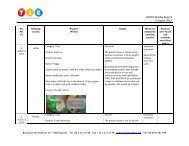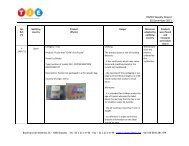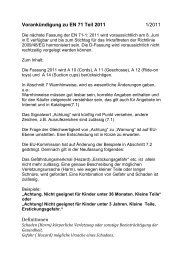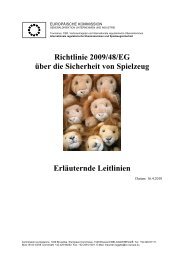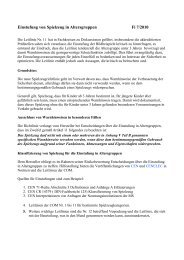Create successful ePaper yourself
Turn your PDF publications into a flip-book with our unique Google optimized e-Paper software.
<strong>EN</strong> <strong>71</strong>-1:<strong>2005+</strong><strong>A8</strong>:2009 (E)<br />
considerable forces which can be applied to the edges of the hinge line when the door or lid is closed or<br />
opened.<br />
It has not been considered possible to specify a hinge area instead of hinge line. Manufacturers should,<br />
however, consider this and try to reduce the associated hazards, e.g. by allowing for a 12 mm clearance<br />
between moving parts near the hinge line.<br />
A.14 Springs (see 4.10.4)<br />
These requirements are intended to address the pinching or crushing hazards to fingers, toes and other parts<br />
of the body, associated with toys with springs.<br />
A.15 Mouth-actuated toys (see 4.11)<br />
These requirements are intended to address the asphyxiation hazard associated with unintentional inhalation<br />
of mouth-actuated toys or their mouthpieces.<br />
It is essential that such toys as well as removable mouthpieces and mouthpieces of toys which become<br />
detached when tested according to relevant requirements (e.g. the mouthpiece of a trumpet), are not so small<br />
that they can be unintentionally swallowed or inhaled.<br />
To ascertain that small parts do not come loose when a mouth-actuated toy like a harmonica or whistle is<br />
used, these toys are subjected to a sucking and blowing test where a specified volume of air is forced through<br />
the toy.<br />
This requirement applies regardless of the age of the child for whom the toy is intended.<br />
A.16 Balloons (see 4.3, 4.12 and 7.3)<br />
Balloons may be made of expandable latex or plastic. Plastic balloons made of metallized plastic are normally<br />
stronger than latex balloons and do not present the same choking or suffocation hazards. They therefore do<br />
not require the warning text in 7.3 (latex balloons).<br />
Latex balloons are not covered by 4.3 (flexible plastic sheeting) as they are not made of plastic. Plastic<br />
balloons are normally so strong that they cannot be taken apart by a child and the thickness of the plastic<br />
sheeting should therefore be measured with double layers of sheeting (i.e. without tearing the balloon apart).<br />
Products made from natural rubber latex may cause severe allergic reactions in some individuals. It is<br />
therefore important that balloons made from natural rubber latex are marked accordingly (see 7.3, latex<br />
balloons).<br />
A.17 Cords of toy kites (see 4.13)<br />
These requirements are intended to address the electrocution hazard associated with toy kites that come in<br />
contact with overhead power lines. They also highlight the danger of flying a toy kite in thunderstorms.<br />
A.18 Toys which a child can enter (see 4.14.1)<br />
These requirements are intended to address the asphyxiation hazard associated with toys which might entrap<br />
and enclose the child completely (e.g. tents and toy chests).<br />
80



